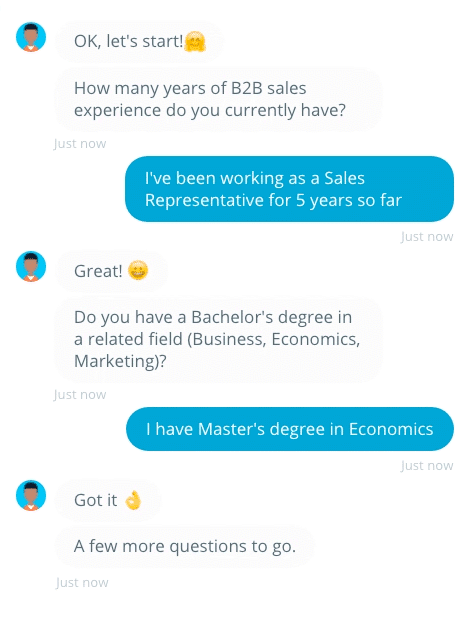We get it: you have enough on your plate as a recruiter—taking the time to reach out to a candidate at every step sounds daunting.
Communicating well and often with job candidates can seem more like a nice idea than an actionable task, but it can make for a great candidate experience and help your brand in the long-run. Here are a few reasons:
- It impacts your employer branding
- It makes potential hires more likely to accept your offer
- It makes rejected candidates more likely to reapply in the future
- It makes hired candidates more likely to stay
If you don’t have a candidate engagement process yet, starting one from scratch will take a bit of work. But once you’ve got one in place, speedy and empathetic communication with job candidates will flow much more easily.
Here’s how to get started.
1. Map out the stages of your hiring process

A hiring process is a project with stages, associated tasks, and deadlines. Typically, the stages of the recruitment process are:
- Need identification
- Sourcing
- Screening
- Selecting
- Hiring
- Onboarding
Adjust the list above as needed, then map out the tasks associated with each stage.
2. Assign a timeframe for each stage
Once you’ve listed the tasks associated with each stage, decide how much time you’ll need to complete each one.
Tip: Give yourself a little wiggle room to account for unexpected issues, including technical problems that might cause delays.
3. Create communication templates for each stage
Think about what candidates need to know at each stage of the hiring process. Then, create email templates based on these needs. Make sure to consider templates for both the candidates that you are moving forward with and those that you are no longer considering for positions.
Note: Email templates get a bad rap, but they aren’t a bad thing—and they’re essential when you have to communicate the same things over and over again to a large number of people.
With tools such as TextExpander, you can create templates with fill-in fields to quickly create messages and personalize them.
Don’t forget to plan communication with candidates after they’re hired. An often overlooked part of the recruitment life cycle, onboarding is crucial to employee retention. See Onboarding below.
Other candidate engagement ideas to consider
Recruiting bots
Like other types of AI recruitment tools, bots can help increase candidate engagement and improve the candidate experience.

You can incorporate bots at all stages of the recruitment life cycle, including:
- The screening stage, for asking candidates questions
- Throughout the hiring process, for providing updates
- The end of the recruiting process, for notifying applicants that a position has been filled
The biggest advantage of using bots in recruiting is that they are available 24/7 for real-time interaction with candidates.
Note: We would not recommend using bots to let candidates know they are not moving forward in the process. Research has shown that candidates tend to appreciate a more human approach to rejections. For example, they prefer getting the bad news over the phone than via an automated email.
Text recruiting
SMS messaging can be an easy, quick, and effective way to keep job candidates informed and engaged.

The strategic use of texts in recruiting can shorten the time to hire and improve the candidate experience.
You can send texts at all stages of the recruitment life cycle, including:
- The sourcing stage, to message passive candidates inviting them to apply for a job opening.
- The screening and selecting stages, to ask quick yes/no questions and schedule phone screens.
- The onboarding stage, to send welcome messages and check in with new hires.
Text recruiting requires text marketing software, which, much like email marketing software, enables you to efficiently send messages to large numbers of people.
With text recruiting software, you can send bulk texts, schedule messages, and create targeted drip campaigns from your computer.
Onboarding
The first few months of a new hire are extremely fragile—a survey of over 1000 employed US workers showed that 68 percent of people leave their jobs within three months of being hired.
Given how likely new hires are to leave a job, consider ways to ensure that they feel empowered. For example:
- Develop documentation explaining how things work. Aim to include anything that the new employee might tap someone on the shoulder to ask about in their first months on the job.
- Create a journey for new hires to follow. It could be as simple as a Trello or Basecamp checklist with tasks designed to help them understand the company and its processes, as well as the team etiquette.
- Check in regularly with new hires for the first three months. You can set these meetings ahead of time so you don’t forget.
Conclusion
Keeping candidates informed and delighted can be tough when you don’t have a process in place.
But taking the time to build a candidate engagement strategy pays off: doing so will strengthen your employer brand and help you maintain your recruitment pipeline.
We recommend getting started with three simple steps:
- Map out the stages of your hiring process
- Assign a timeframe for each stage
- Create communication templates for each stage
You may also want to consider adding recruiting bots and text recruiting to your toolkit.
Communication is also important after you’ve made your hires. Make sure your candidates-turned-employees feel confident and competent. Providing timely and helpful information and checking in regularly go a long way in ensuring new hires feel motivated and empowered.
Over to you: What strategies do you use to keep candidates engaged throughout the hiring process?



